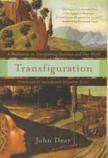Journey Toward Peace
The elder monk rose in reply and stretched his hands toward heaven, his fingers becoming like torches of flame. Why not be turned into fire? he asked.
Abba Joseph’s question comes to mind while reading John Dear’s urgent meditation on Christ’s transfiguration atop Mount Tabor as recorded in the Synoptics. The Gospel is the measure of our lives, writes Dear, who finds in the Transfiguration story much instruction on how to live out the Christian mission of making peace. A priest and peace activist, Dear espouses a practical, deeply compassionate theology. His newest book, Transfiguration, is, thankfully, free of abstract discourses on the nature of Christ. Each section of his five-part meditation contains reflections, questions and a prayer, offered as guides for the transfiguration journey. In Dear’s view, the transfiguration is more than a uniquely Christic event; it is a noun to be applied in today’s world, so disfigured by fear and violence.
The spiritual life is a journey with God through life toward death and new life, Dear writes. Christ has laid the course. If we but follow in his footsteps, our lives, no longer a movement from crisis to crisis, from death to death, will radiate his story. We too will serve the poor, heal the broken, liberate the oppressed, speak up for justice and make peace. We too will be transfigured.
This journey inevitably requires ascending a mountain, God’s favored geography for revelation. Everyone needs a mountain, claims Dear, who provides many examples of prophets and saints hiking to higher ground in search of God. Moses trekked Mount Sinai. Elijah ascended Mount Horeb. St. Francis retreated to Mount Salerno. Whether or not we literally undertake a climbing expedition or spiritual pilgrimage, the mountain is where we rise above our violences to gain perspective and receive our mission. Reflecting on the prophet Isaiah’s description of the mountain of God (Isa 2:2-5), Dear concludes the mission will always be disarmament and peace. We will be told loudly and clearly to take apart our weapons, institutionalize nonviolent social justice, and create a new, nonmilitary, nonviolent peaceful world.
Christ’s own mountaintop experience, a story full of curious detail, provides the centerpiece for Transfiguration. Accompanied by Peter, James and John, Jesus ascends Mount Tabor to pray. What follows is hardly a conventionally contemplative experience. While praying, Christ lights up like a supernova, his raiment turning an unearthly white. He converses with dead prophets. Drowsy disciples speak of building tabernacles. A cloud descends. God speaks briefly. Then the night becomes ordinary again.
The event on the mountain is Christ’s moment of full disclosure, when he became the Christ he would become. Present and future are suffused: the miracle-performing rabbi is revealed as God in full glory. Dear probes this moment thoroughly, seeking to understand what it says about Christ’s life and therefore our own. The prophets on Mount Tabor are not men of political powerno King David or Solomon herebut Moses, the liberator, and Elijah, the visionary. They are there to console Christ and confirm that the course ahead does indeed include political confrontation and execution. The drowsy disciples remind Dear of the Catholic Church, eager to institutionalize God’s revelation, yet often clueless about its import. For two thousand years, he writes, churchmen have slept through an enormous array of transfigurations, those social movements working for peace and justice that have shown the glory of God working in our tragic world....
The transfiguration Dear describes is part of a continuum. We ascend the mountain with Jesus, witness his transfiguration and then descend with him back into the world to confront injustice and proclaim God’s reign. The world below is a place contorted by cruelty, as evidenced in Dear’s discussion of the demonic U.S. atomic bombing of Hiroshima and his nontraditional interpretation on the Gospel of Mark’s account of Jesus healing the boy possessed by demonsChrist’s first act after he descends from Tabor. Dear identifies war as the possessing demon. It takes us over, leads us to scream and shout, induces us to murder and support mass murder, leaves us rigid and kills our spirit.
Transfiguration concludes with contemporary examples of individual and social transfiguration. The story of Dr. Martin Luther King Jr.’s midnight encounter with God, experienced while King was overcome with fear and exhaustion, is deeply moving. Transfiguration moments, those occasions when God affirms a struggle, are not cheap or easy.
Dear’s meditation grew out of his own faith journey during these last difficult years for the Church and the world. The world is very present in Transfiguration, whose activist angle may irk some readers. How can a passage about Christ’s mountain getaway yield such a concrete manifesto on peacemaking? But Dear’s premise is unquestionably contemplative, fundamentally Christian: Peace requires knowing Jesus. The Jesus Dear invites us to encounter is a nonviolent revolutionary, an unconditional lover, a God whose light shines among the poor.
Mountaintop retreats as well as Dear’s work among the poor and victims of war have inspired his unequivocal call to pray and disarm. Given the Gospel he consults and the world he sees, who can fault him for the intensity of his plea? As the poet Mary Oliver asks, Can one be passionate about the just, the ideal, the sublime, and the holy, and yet commit no labor to its cause? The gospel of light is the crossroads ofindolence or inaction/ Be ignited, or be gone.
This article also appeared in print, under the headline “Journey Toward Peace,” in the April 2, 2007, issue.








